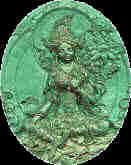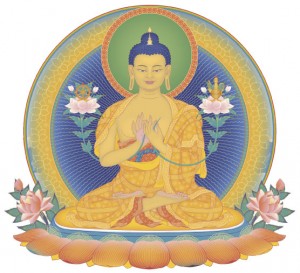
Kadampa Buddhism - NKT
The Kadampa tradition was founded in Tibet by the Indian teacher Atisha (982 - 1054). Up
to the time of the great reformer Lama Tsongkhapa (1357 - 1419) it was known as the Old
Kadampa Tradition. After the time of Lama Tsongkhapa it is known as the New Kadampa
Tradition ( NKT ).
Initially there were two principle lines of teaching (lineages) passed down from Buddha Shakyamuni. These were the wisdom lineage of Nagarjuna and the method lineage of Asanga.
The wisdom lineage, which emphasises the teachings on sunyata, or emptiness of inherent existence, passed from Buddha Shakyamuni to Manjushri, from Manjushri to Nagarjuna, then to Chandrakirti and further Indian Buddhist masters.
The method lineage, which emphasises moral discipline and compassion, passed from Buddha Shakyamuni to Maitreya, from Maitreya to Asanga and then to Vasubandhu and further Indian masters.
The great Indian teacher Atisha gathered these two lineages together and brought them to Tibet, where Buddhism, originally introduced by Padmasambhava, had been seriously weakened by persecution. Atisha successfully revived Buddhism in Tibet. His principal teachings are known as Lamrim and are set down in 'Lamp for the Stages of the Path'.
Lama Tsongkhapa (1357 - 1419) was born at a time when Tibetan Buddhism was being undermined by confusion. He single-handedly reformed and revitalised Tibetan Buddhism giving it the clarity and impetus which has lasted to the present day. Eminent modern Kadampa scholars have included Je Pabongkhapa, Kyabje Trijang Rinpoche and Geshe Kelsang Gyatso. Geshe Kelsang Gyatso is a noted translator and author who is responsible for the introduction of Lama Tsongkhapa's teachings to western readers. A very brief introduction to Kadampa meditational practice is given in the meditation page of this website.
The first New Kadampa centre in the west was established during the late 1970's at Conishead Priory, just outside the old market town of Ulverston in the English Lake District. This was the mother centre from which over 200 centres have been set up throughout the western world.
The NKT is the second major spiritual tradition to establish its home base in this small town. The first was the Quakers. George Fox, the founder of The Society of Friends (Quakers) lived at Swarthmoor Hall (known as the 'cradle of Quakerism') on the Western side of Ulverston. Fox opposed what he regarded as corruption within the church caused by the mixing of religion with worldly power. His wife, Margaret, was imprisoned for claiming that women were capable of giving religious teachings. The Quakers objected to religious beliefs being imposed by coercion and abuse of authority. Their influence spread from Ulverston and eventually reached world-wide fruition in the works of the great social reformers of the nineteenth and early twentieth centuries.
